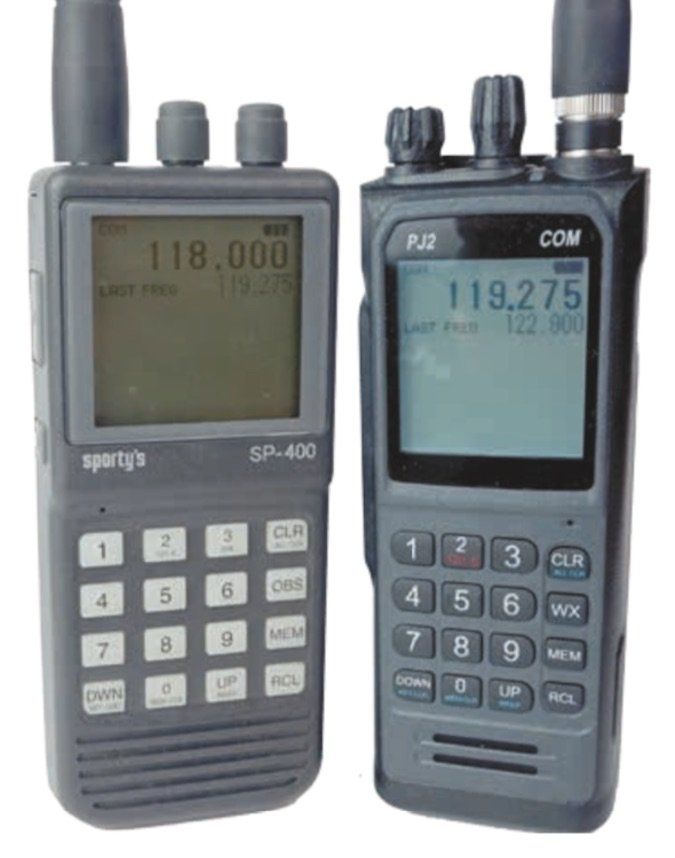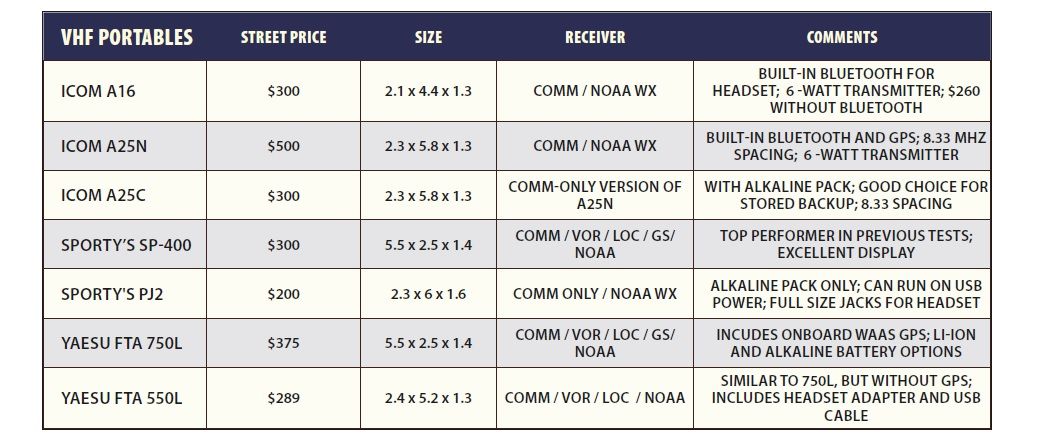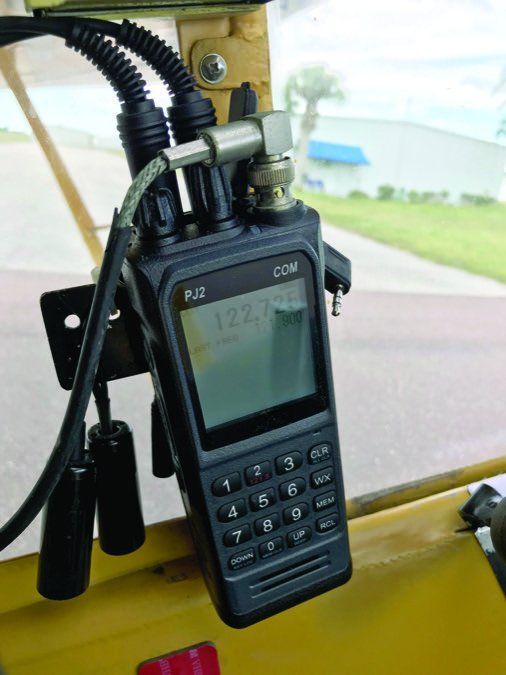For a couple of hundred bucks, why argue about whether a handheld VHF radio is worth having? Top-of-the-line tablets can cost five times as much and navigate with lan, but no comm. The VHF market isn’t nearly so vibrant as things that run apps, but Sporty’s is out with a new one called the PJ2.
With the exception of accepting the full-sized jacks on a standard aviation headset rather than requiring a cheesy adapter, there’s not much new in the PJ2. But Sporty’s figured it was time for a product refresh, so here we are.
Heretofore, we’ve been impressed with Sporty’s iteration of the portable VHF, specifically, the SP-400 that’s festooned with not just a 760-channel radio, but VOR and ILS functions that actually work. At $199, the new PJ2 isn’t meant to replace the SP-400. It will stay in the product line, says Sporty’s, at $299, even if those higher-level functions have been displaced by the nav capabilities in a tablet or smartphone or Garmin’s GPS portables.
SP-400 Stays
The SP-400 is ably manufactured by Japan Radio, but for the PJ2, Sporty’s found a new vendor called Rexon, a Taiwanese company with a modest line of portable radios, including a VHF aviation model. Because Sporty’s didn’t like the operating logic of Rexon’s off-the-shelf RHP-530, despite its $40 lower retail price, it commissioned Rexon to build a clean-sheet design for its new radio, says Sporty’s Doug Ranly. “No one knows about it [RHP-530] because it’s not very user friendly. That’s one reason we didn’t want to sell it because of complications in programming and using it,” Ranly says.
Customers have complained about various nits in the SP-400 and the Icom line, but one consistent complaint is having to haul around an adapter and a push-to-talk switch to use these radios with a standard headset. While you’d certainly want to do that in the airplane with the radio in the backup role, a headset-especially a noise-canceling model-just delivers better performance even on the ground or on the ramp.
Big Jacks
The standard-size jacks are on top of the chassis behind the two knobs used for on/off and squelch. They’re equipped with rubber caps to keep the inevitable flightbag lint and cookie crumbs from tanking the radio’s guts.
They’re accessible enough, but it’s a tight fit because the top of the chassis is as small as it can possibly be to keep the form factor more or less standard. I tried the PJ2 in our Cub, where a portable-an Icom IC-A6 lately-serves as full-time comm. This lash-up requires a push-to-talk switch and the generic PTT we’ve had for five years worked both with the jacks plugged directly into the radio and through the airplane’s Avcomm AC-2EX portable intercom.
As is the fashion these days with gadgets of all kinds, the PJ2 has more high-level features than most users will ever need or want. I mean really, we just wanna talk back and forth a little, have enough power to do that and maybe store a few frequencies. The PJ2 does all that and more, of course.
It will store up to 20 frequencies and has a last-frequency flip-flop that’s handy when the radio is primary comm and you want to sneak a listen at the AWOS before flipping back to CTAF. It also has discrete channels for NOAA’s weather channels. Ranly said one design goal was large, easy-to-use frequency input buttons and the input logic is predictable: Punch in all six digits of a frequency and the radio will automatically tune it. There’s no need to push enter. There’s a single button to flip one frequency to the standby window. Scrolling the other stored frequencies is done through a dedicated recall button, which lists the freqs that you can then scan through to select.
Power is provided by six AA alkaline cells; there’s no rechargeable option. Well, let me qualify that. The radio ships with a USB-C cable that can be plugged into a standard 2.4-watt USB charger to run the radio. (A lower-wattage charger won’t provide enough power to transmit.) You can also use one of the Flight Gear backup lithium-ion packs that Sporty’s sells.
Good Performer

For ground and on-the-ramp use, the onboard rubber-duck antenna is adequate to summon the fuel truck or check AWOS. The transmitter is rated at 5 watts peak envelope power, but like other handhelds, it radiates about 1.5 watts in general use. That’s a relative whisper compared to a 10-watt panel mount transceiver so don’t expect comparable performance. And don’t expect much of anything unless the radio is connected to an external antenna with a cable terminating conveniently in a BNC connector in the cockpit.
Our Cub has one of those installed inside the fuselage cage on a ground plane behind the pilot’s seat. Conceding that this antenna probably doesn’t perform as we’ll as one installed outside the cage, the PJ2 still functioned we’ll for routine Unicom and CTAF calls in the pattern. Comm checks with control towers up to 12 miles away yielded readable but scratchy signal quality reports. But it took several calls to get a reply and some ATC frequencies never did respond. Distant airborne aircraft returned good signal reports.
If the PJ2 has a shortcoming, it’s display readability. It has brightness and contrast controls and reverse contrast for night use, but scrolling through these various options never yielded a display quite as readable as Icom’s or even the SP-400.
Yes, it was functional, but with effort and not without removing sunglasses. The audio quality and sidetone-both through the radio and the intercom-were crisp and readable.
If you already have a VHF portable-whether seldom or frequently used-the PJ2 doesn’t bring enough to the party to consider replacing an older radio. The SP-400 is a more capable radio and has the VOR and ILS options. In the age of ubiquitous and cheap GPS, these are unlikely to be pressed into use, but they’re there if you want them.
If you have no VHF portable at all, the PJ2 is a good, bargain-price choice and Sporty’s has a good rep for supporting such products after the sale.






